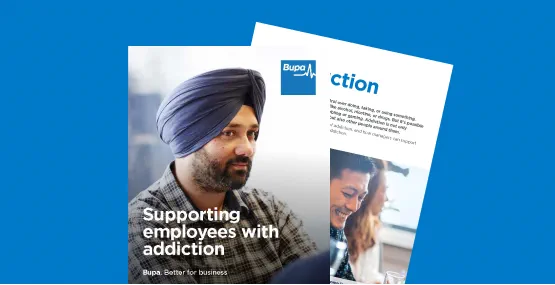Addiction: nurture and nature
Alcohol, illegal drugs and nicotine are the substances which probably come to mind when we think about addiction.
However, addiction is much wider than substance dependency. It can extend to behaviours such as gambling, video gaming and pornography.

Dr Naveen Puri, Medical Director for Bupa UK Insurance, says,
“In simple terms, an addiction is anything which stimulates dopamine reward pathways in the brain. It establishes a craving for something to the point where a want becomes a need.
Compulsive behaviour
Dr Puri adds,
“This is often associated with compulsive behaviour and people with addictions developing a tolerance to the substance or behaviour they crave, which can lead to increased risk-taking.”
The full extent of addiction in the UK is difficult to gauge. Although, statistics suggest that everyone knows at least one person who is struggling with a dependency."
"Many will be perceived as ‘functioning addicts’ who are still able to maintain a facade of coping. Addiction is rarely obvious.”
More common in men
Substance misuse is more common in men. But the gap is narrowing and there is evidence that women escalate to dependency quicker than men.1 Alcohol is one of the most common problems. The number of people drinking at dependency-level climbed sharply during the pandemic.2
Adults aged 45 to 64 are the heaviest drinkers. In this age group, 37% of men and 19% of women are consuming more than the recommended maximum of 14 units a week.3
For context, a single shot of spirit is 1 unit. A pint of lower-strength lager, beer or cider is 2 units. A 250ml glass of wine is 3 units.4
Drug use is more common in 16 to 24-year-olds. In this age group, one in five admit to taking illegal drugs.
Overall, one in 11 adults aged 16 to 59 — approximately 3 million people — reported using illegal drugs in 2022.5
Addictive personality?
At one time, psychologists believed particular traits created an addictive personality. This would mean that some people might be at greater risk of dependency than others.
Professor Mark Griffiths, Director of the International Gaming Research Unit, Nottingham Trent University, says this is a myth.6
“In all the papers I have ever read concerning ‘addictive personality’, I have never read a good operational definition of what an ‘addictive personality’ actually is.
“Not every addict has a personality disorder. Not every person with a personality disorder has an addiction.”
Multiple drivers
Dr Puri explains,
“Addiction is complex and often involves multiple drivers. These include genetics, poor mental health, and environmental factors such as peer pressure, the availability of a substance or activity and whether or not it is socially acceptable.”
Twin and adoption studies suggest genes are a factor in 50% of cases of alcohol addiction. They're even higher for opioid addiction.7
Overall, inherited risk is thought to contribute to 40% of addictions. This is most likely a result of genetic variations in dopamine response.8
Women are at greater risk of inherited dependency. Studies suggest genes are a factor in:
64% of alcohol misuse in females, compared to 49% in males.
For tobacco, the figures are 62% and 53% respectively.
For cocaine addiction, it is 65% compared to 44%.
And for cannabis, it’s even higher — 79% in women versus 33% in men.
Reward pathways
Another issue is that habits can become habit-forming as the brain’s neural processes and reward systems are rewired. This is because elevated levels of dopamine lead to increased sensitivity to glutamate — a brain chemical associated with learning and cue-related behaviours.8
Dopamine, and this reward pathway, is also the driver for behavioural addictions such as gambling, video gaming, excessive use of pornography and sex-addiction.
Brain scans of cocaine users reveal that erotic images activate the same brain circuits as drug-related images. Similarly, scans show that prolonged exposure to online pornography alters brain signalling and desensitises the viewer.8
ADHD and mental health
Dopamine dysregulation is often a factor in attention deficit hyperactivity disorder (ADHD).9 This may explain why ADHD, conduct disorder and depression in adolescence are associated with an increased risk of alcohol, cannabis and nicotine addiction.10
However, Dr Puri says,
“This risk is reduced when ADHD is treated. So it is likely that timely intervention and treatment will help to mitigate other risk factors for dependency.”11
Exposure to drugs during adolescence heightens the risk of addiction in later life. This is largely because the brain is still developing and the executive functions which govern decision making and impulse control are among the last to mature.12
There is also a strong correlation between schizophrenia and addiction. Possibly because the same genes which contribute to the risk of psychosis make people vulnerable to drug dependency. Alcohol or drugs, particularly cannabis, also exacerbate symptoms.12
Dr Puri adds,
“Many people use alcohol to unwind, particularly when they’re stressed, and this is embedded in many social situations and cultures. “But alcohol is a depressant so, in the long term, this coping mechanism can slip into an unhealthy dependency.”
Providing support
Dr Puri concludes,
“Developing effective strategies to manage stress, addressing any mental health issues and keeping an eye on your alcohol intake and other behaviours will help to reduce the risk of dependency.
“If there is an issue, the first step to recovery is acknowledging a potential problem and seeking help.
“Studies confirm the value of workplace interventions, and providing effective support makes sound business sense.”13
Resources from the Workplace Health and Wellbeing Academy

Managers guide: Addiction

Managers guide: Mental health in the workplace
1 Fonseca, F., Robles-Martínez, M., Tirado-Muñoz, J. et al. A Gender Perspective of Addictive Disorders, 2021, DOI: 10.1007/s40429-021-00357-9
2 Alcohol in England, January 2024.
3 House of commons library, Alcohol Statistics: England, July 2021.
4 NHS, Alcohol units, 2021.
5 Office for National Statistics, December 2022.
6 Global Journal of Addiction & Rehabilitation Medicine, The Myth of ‘Addictive Personality, DOI: 10.19080/GJARM.2017.03.555610 (PDF, 0.3MB)
7 Neuropsychopharmacol, Heilig, M., MacKillop, J., Martinez, D. et al. Addiction as a brain disease revised: why it still matters, and the need for consilience, 2021, DOI: 10.1038/s41386-020-00950-y
8 Journal of Psychosexual Health, Jha A, Banerjee D. Neurobiology of Sex and Pornography Addictions: A Primer, 2022, 4(4):227-236. DOI: 10.1177/26318318221116042
9 National Library of Medicine, Attention-deficit-hyperactivity disorder and reward deficiency syndrome, October 2008, 4(5):893-918. DOI: 10.2147/ndt.s2627
10 National Library of Medicine, Identifying Early Risk Factors for Addiction Later in Life: A Review of Prospective Longitudinal Studies, March 2020, 7(1):89-98. DOI: 10.1007/s40429-019-00282-y.
11 National Institutes on Drug Abuse (US), Common Comorbidities with Substance Use Disorders Research Report, April 2020.
12 National Library of Medicine, the link between schizophrenia and substance use disorder: A unifying hypothesis, April 2018, 194:78-85. DOI: 10.1016/j.schres.2017.04.016
13 National Library of Medicine,The effectiveness of workplace interventions for the prevention of alcohol use: A meta-analysis, November 2023, 118(11):2043-2061. DOI: 10.1111/add.16276.


